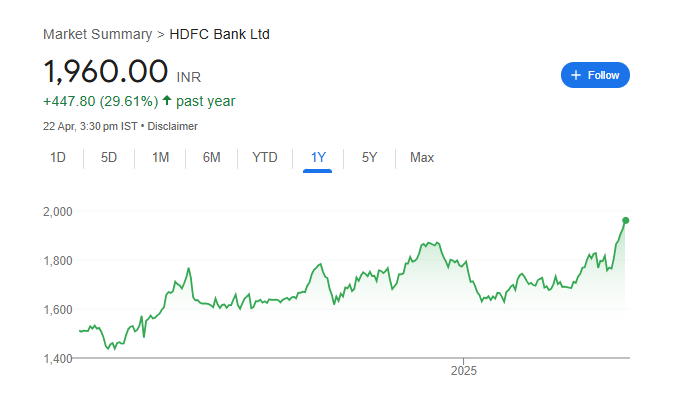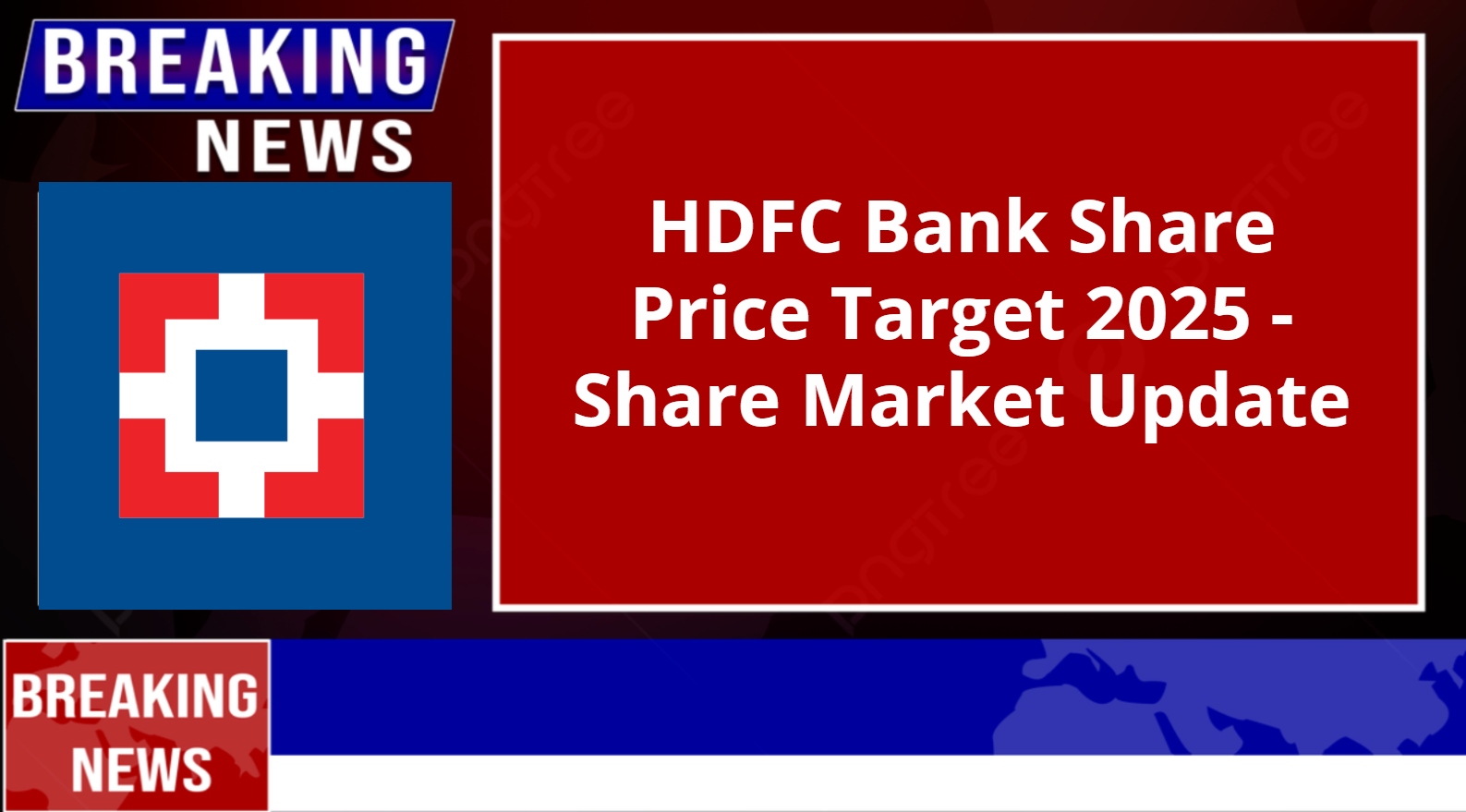HDFC Bank Share Price Target 2025 – Share Market Update
HDFC Bank Limited is one of India’s leading private sector banks, headquartered in Mumbai. Established in 1994, the bank has grown to become a major player in the Indian banking industry, offering a wide range of financial products and services. These include personal and business banking, loans, credit cards, insurance, and investment services. With a vast network of over 8,900 branches and 21,000 ATMs across the country, HDFC Bank serves millions of customers, providing accessible and efficient banking solutions. HDFC Bank Share Price on NSE as of 22 April 2025 is 1,960.00 INR.
Current Market Overview Of HDFC Bank Share
- Open: 1,935.00
- High: 1,970.60
- Low: 1,935.00
- Mkt cap: 15.01LCr
- P/E ratio: 21.53
- Div yield: 0.99%
- 52-wk high: 1,970.60
- 52-wk low: 1,426.80
HDFC Bank Share Price Chart

Shareholding Pattern For HDFC Bank
- Promoter: 0%
- FII: 48.3%
- DII: 35.86%
- Public: 15.84%
HDFC Bank Share Price Target Tomorrow
| HDFC Bank Share Price Target Years | HDFC Bank Share Price Target Months | HDFC Bank Share Price |
| HDFC Bank Share Price Target 2025 | April | ₹1961 |
| HDFC Bank Share Price Target 2025 | May | ₹1962 |
| HDFC Bank Share Price Target 2025 | June | ₹1963 |
| HDFC Bank Share Price Target 2025 | July | ₹1964 |
| HDFC Bank Share Price Target 2025 | August | ₹1965 |
| HDFC Bank Share Price Target 2025 | September | ₹1966 |
| HDFC Bank Share Price Target 2025 | October | ₹1968 |
| HDFC Bank Share Price Target 2025 | November | ₹1969 |
| HDFC Bank Share Price Target 2025 | December | ₹1970 |
Key Factors Affecting HDFC Bank Share Price Growth
Here are six key factors that can influence the share price growth of HDFC Bank:
1. Strong Financial Performance
HDFC Bank has demonstrated consistent financial growth. In the fourth quarter of FY25, the bank reported a net profit of ₹17,616 crore, marking a 6.7% year-on-year increase. Additionally, its net interest income rose by 10.3% to ₹32,070 crore. Such robust earnings can boost investor confidence and positively impact the share price.
2. Improved Asset Quality
The bank’s asset quality has shown improvement, with gross non-performing assets (NPAs) decreasing to 1.33% in March 2025 from 1.42% in the previous quarter. Better asset quality indicates effective risk management, which can enhance the bank’s reputation and attract investors.
3. Strategic Merger and Expansion
The merger with Housing Development Finance Corporation (HDFC) has expanded the bank’s customer base and product offerings. Post-merger, HDFC Bank aims to achieve a loan-to-deposit ratio of 85%-90% by FY27, aligning with pre-merger levels. This strategic move positions the bank for long-term growth.
4. Positive Market Sentiment
Following strong quarterly results, HDFC Bank’s share price surged, making it the third Indian company to reach a market capitalization of ₹15 lakh crore. Such milestones can generate positive market sentiment and attract more investors.
5. Analyst Upgrades and Target Price Increases
Several brokerage firms have upgraded HDFC Bank’s stock rating and raised their target prices, citing strong earnings and growth prospects. Revised target prices now range between ₹2,200 and ₹2,350 per share. Analyst optimism can influence investor decisions and drive share price growth.
6. Economic and Regulatory Support
The Reserve Bank of India’s recent liquidity measures have eased funding pressures on banks, benefiting institutions like HDFC Bank. Such regulatory support can enhance the bank’s operational efficiency and profitability, contributing to share price appreciation.
Risks and Challenges for HDFC Bank Share Price
Here are six key risks and challenges that could impact HDFC Bank’s share price:
1. High Loan-to-Deposit Ratio (LDR)
After merging with HDFC Ltd., HDFC Bank’s loan-to-deposit ratio increased significantly, reaching 110.5% in early 2024. Although it has improved to 96.5% by March 2025, it remains above the ideal range. A high LDR indicates that the bank is lending more than it has in deposits, which can strain liquidity and affect profitability.
2. Pressure on Net Interest Margins (NIMs)
The merger introduced a large portfolio of home loans, which typically yield lower interest rates. This shift has led to a decline in the bank’s net interest margins, dropping from over 4% pre-merger to around 3.4%. Lower NIMs can reduce the bank’s earnings and impact investor sentiment.
3. Regulatory Compliance Issues
The Securities and Exchange Board of India (SEBI) issued a warning letter to HDFC Bank for non-compliance related to its custody and merchant banking activities. Such regulatory concerns can affect the bank’s reputation and lead to increased scrutiny, potentially influencing its share price.
4. Rising Retail Loan Defaults
There has been an uptick in defaults among retail borrowers, particularly in personal loans and micro-credit segments. This trend has led to increased provisions for bad loans, which can impact the bank’s profitability and investor confidence.
5. Intensifying Competition from Fintechs
The rise of digital-only banks and fintech companies is increasing competition in the banking sector. These new entrants often offer innovative services and competitive rates, which can pressure HDFC Bank to invest more in technology and potentially reduce its margins.
6. Foreign Investor Selling
Foreign Institutional Investors (FIIs) hold a significant portion of HDFC Bank’s shares. Changes in global economic conditions or investor sentiment can lead to FIIs selling their holdings, which may result in increased volatility and downward pressure on the bank’s share price.
Read Also:- NLC Share Price Target 2025 – Share Market Update

